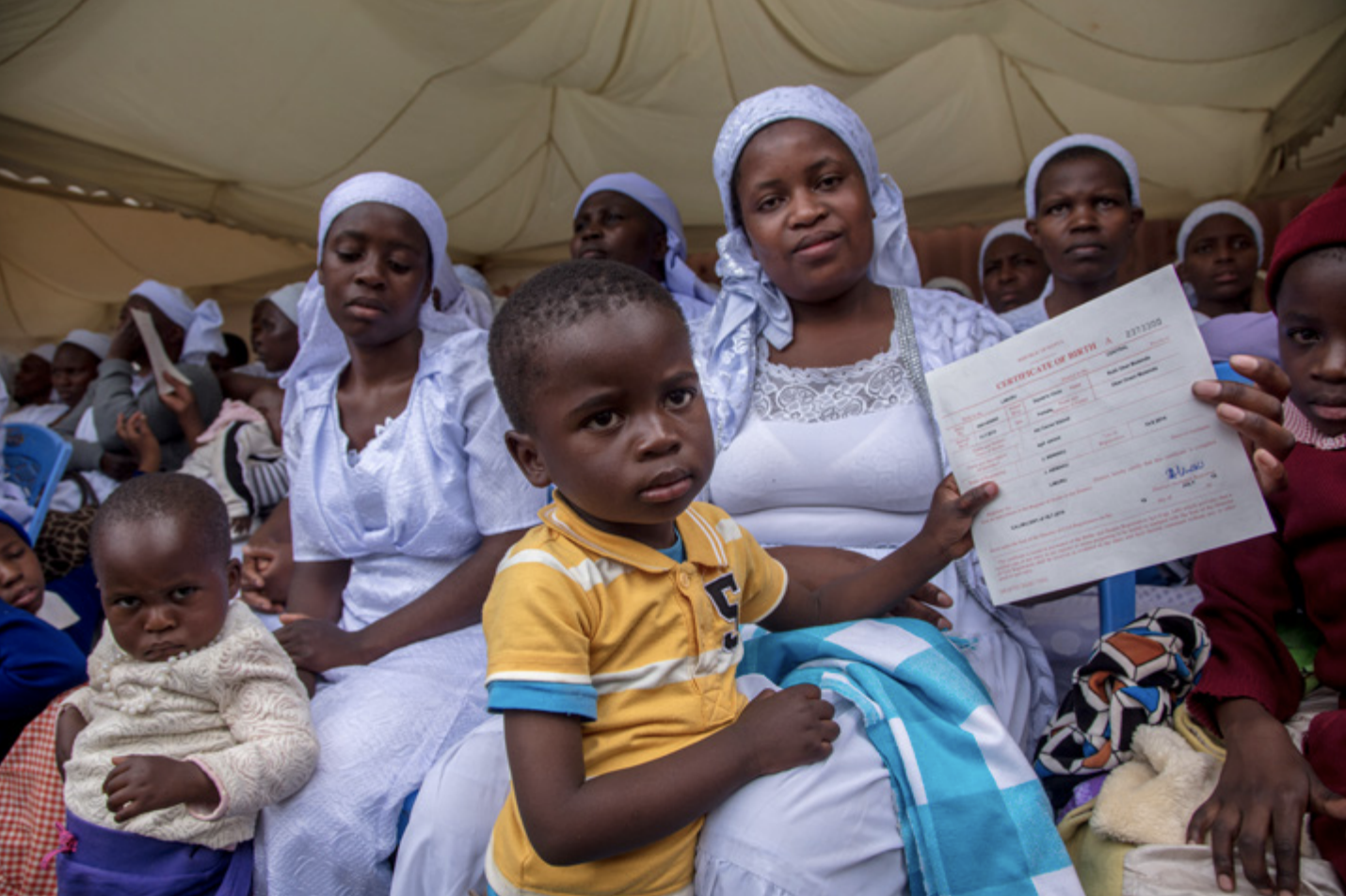
Aki Sibindi, 24, with her son Milton, 3, holds her children’s birth certificates at a ceremony on the outskirts of Nairobi to recognise families of Shona, a stateless community, as Kenyans. © UNHCR/Georgina Goodwin
UNHCR’s mandate to address statelessness has evolved significantly since 1951 from holding responsibilities for stateless refugees only, to identifying and protecting non-refugee stateless people, and preventing and reducing statelessness in itself. In 2014, UNHCR increased its efforts and established the Global Action Plan to End Statelessness: 2014 — 2024 (GAP) as a guiding framework for its #IBelong Campaign to End Statelessness by 2024.
This evaluation was commissioned by the UNHCR Evaluation Service to generate evidence and insights regarding UNHCR’s work to support States to end statelessness and was timed to inform potential adjustments for the remaining 3 years of GAP implementation. It covers the period of 2001 to 2020 with a particular focus on actions and advocacy efforts by UNHCR and partners to support the GAP since its launch in 2014.
The evaluation consisted of five key phases: the inception phase; remote data collection phase (global survey, interviews with internal and external stakeholders, documentation reviews); ‘deep dives’ into four country operations (Cote d’Ivoire, Kenya, the Philippines, and Tajikistan); three regional case studies (Americas, Europe, and the Middle East and North Africa (MENA); consultations with Regional Engagement Groups in Africa and Asia and; finally an analysis, validation and report writing phase. The final draft report was also subjected to a review by a Reference Group, comprising senior stakeholders from UNHCR and key partner agencies.
The evaluation finds thatUNHCR and partners have positively impacted the lives of many stateless people and those at risk of statelessness – this is demonstrated by the number of people that have acquired nationality; the stories about the value of gaining citizenship and, the many good and innovative initiatives to prevent and resolve statelessness. By working together, UNHCR and partners have successfully raised awareness of statelessness and begun to build the necessary political will and capacity to prevent and resolve statelessness. Since 2001 there has been a growing dialogue on statelessness and more political will to act, with notable successes in particular countries and regions, as well as at the global level.
The GAP has been a useful framework for guiding States, UNHCR and other partners – its broad scope allows for application in a range of different contexts. Global diplomatic events, such as the 2011 Ministerial Intergovernmental Event and the 2019 High-level Segment on Statelessness have inspired momentum and pledges for future action. Within UNHCR, in the absence of a strong theory of change for ending statelessness, the Global Strategy and Implementation Plan for the Campaign to End Statelessness 2016 – 2018 has provided a foundation for setting organizational direction.
Despite successes, the ambitions of the campaign and targets set within the GAP have proven to be highly aspirational and are unlikely to be achieved by 2024. The challenges of statelessness will continue to remain beyond the lifetime of the Campaign. The most significant progress on granting nationality and mainstreaming and institutionalizing actions to end statelessness was seen in the period leading up to the launch of the Campaign. Since, statelessness tools and resources to support planning have continued to increase and improve, while overall resourcing has not grown. Experience has proved that ending statelessness is a long-term and complex undertaking, which is highly dependent on political will and susceptible to setbacks – including other crises, such as COVID-19 – that can divert attention and either slow or reverse progress.
Recommendations
UNHCR cannot act alone to end statelessness. It can, however, devote renewed energy, linked to a whole of society approach, to engage and mobilise stateless people and actors from all sectors of society, at global, regional, national levels.
Key recommendations:
- Strengthen UNHCR’s integrated global cross-divisional leadership of the campaign in its remaining years and improve prioritisation of activities to address statelessness at all levels of the organization, including clear direction from the High Commissioner to Regional Directors to give higher priority to statelessness.
- Invest in building the statelessness-related knowledge and skills of colleagues – globally – including upskilling of Country Representatives’ knowledge about, and comfort in engaging on, aspects of statelessness, and ensure surge capacity mechanisms are available to fill temporary gaps.
- Enhance organizational capacity and tools for public advocacy on statelessness, including dedicated communications role at Headquarters, Regional Bureau, and in priority countries. Prioritize public advocacy and building public awareness in operational contexts where it can influence changes in policy and practice.
- For the remainder of the campaign, UNHCR should invest in shifting from fragmented bilateral partnerships towards building a lasting multi-stakeholder coalition to end statelessness, with shared ownership and responsibilities, that is replicable at regional and national levels, to carry the statelessness agenda forward after 2024.
- Assess the feasibility of targeted resource mobilisation efforts for statelessness, while simultaneously elevating prioritisation of statelessness in internal resource allocation processes, to ensure sufficient resources for statelessness work. Jointly develop options for financing the statelessness work of UNHCR and its partners in the coalition that follows the campaign.
- Integrate statelessness context considerations into the new multi-year operations planning process and situation analysis tools.
- Integrate the consideration of statelessness in broader development and human rights initiatives and mechanisms to address the broader fundamental discriminatory and exclusionary drivers of statelessness and to strengthen national systems for better collecting data on stateless people.
Read the full report here.
Explore the UNHCR Evaluation Service webpage.
